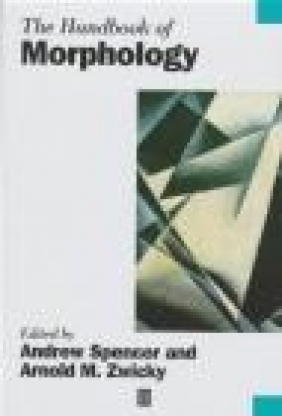Handbook of Morphology
Handbook of Morphology
- Producent: Blackwell Science
- Rok produkcji: 1998
- ISBN: 9780631185444
- Ilość stron: 832
- Oprawa: Twarda
Niedostępna
Opis: Handbook of Morphology
Interest in morphology has undergone rapid growth over the past two decades and the area is now seen as crucially important, both in relation to other aspects of grammar and in relation to other disciplines. The Handbook of Morphology brings together articles by authors at the forefront of this research effort. The chapters deal with traditional issues such as inflection, derivation, compounding, productivity, and various aspects of the interface question, the relationship between morphology and phonology, syntax, and semantics. Other chapters offer briefer discussions of specific questions that have more recently become the focus of attention. A further set of chapters explores the role of morphology in a wider perspective: language change, psycholinguistics, and language acquisition.The Handbook concludes with a set of morphological sketches of a typologically and genetically diverse set of languages, each illustrating one or more particularly interesting morphological traits. "I'm enormously impressed by the scope and depth of "The Handbook of Morphology." The coverage is broadly inclusive, without sacrificing depth in the discussion of individual issues. The range of topics covered shows us just how far the study of words, their forms and their structures has penetrated into the core of linguistics since the 1960s, when many thought there was no distinct content to morphology, and everything interesting was either syntax or phonology." "Stephen R. Anderson, Yale University"
"Its range is outstanding. Every chapter provides new insights and challenges. I think that, like its companion volume, "The Handbook of Phonological Theory", it is destined to become a standard reference in its field." "Laurie Bauer, Victoria University of Wellington"
""The Handbook of Morphology, " edited by two outstanding morphologists, will be much appreciated by the linguistic community at large. It will serve as a guide for graduate students in linguistics, and forList of Contributors. List of Abbreviations. Introduction: Andrew Spencer (University of Essex) and Arnold M. Zwicky (Ohio State University). Part I: The Phenomena: 1. Inflection: Gregory T. Stump (University of Kentucky). 2. Derivation: Robert Beard (Bucknell University). 3. Compounding: Nigel Fabb (University of Strathclyde). 4. Incorporation: Donna B. Gerdts (Simon Fraser University, British Columbia). 5. Clitics: Aaron L. Halpern (Los Alamos National Laboratory / Santa Fe Institute). 6. Morphophonological Operations: Andrew Spencer (University of Essex). 7. Phonological Constraints on Morphological Rules: Andrew Carstairs-McCarthy (University of Canterbury, New Zealand). Part II: Morphology and Grammar: 8. Morphology and Syntax: Hagit Borer (University of Southern California). 9. Morphology and Agreement: Greville G. Corbett (University of Surrey). 10. Morphology and Argument Structure: Louisa Sadler (University of Essex) and Andrew Spencer (University of Essex). 11. Morphology and the Lexicon: Lexicalization and Productivity: Mark Aronoff (State University of New York at Stony Brook) and Frank Anshen (State University of New York at Stony Brook). 12. Morphology and Lexical Semantics: Beth Levin (Northwestern University) and Malka Rappaport Hovav (Bar Ilan University). 13. Morphology and Pragmatics: Ferenc Kiefer (Hungarian Academy of Sciences). Part III: Theoretical Issues: 14. Prosodic Morphology: John J. McCarthy (University of Massachusetts) and Alan S. Prince (Rutgers University). 15. Word Syntax: Jindrich Toman (University of Michigan). 16. Paradigmatic Structure: Inflectional Paradigms and Morphological Classes: Andrew Carstairs-McCarthy (University of Canterbury, New Zealand). 17. Morphology as Component or Module: Mapping Principle Approaches: Richard Sproat (AT+ACY-T Bell Laboratories). Part IV: Morphology in a Wider Setting: 18. Diachronic Morphology: Brian D. Joseph (Ohio State University). 19. Morphology and Language Acquisition: Eve V. Clark (Stanford University). 20. Morphology and Aphasia: William Badecker (The Johns Hopkins University) and Alfonso Caramazza (Harvard University). 21. Morphology and Word Recognition: James M. McQueen (Max Planck Institute, Nijmegen) and Anne Cutler (Max Planck Institute, Nijmegen). 22. Morphology in Language Production with Special Reference to Connectionism: Joseph Paul Stemberger (University of Minnesota). Part V: Morphological Sketches of Individual Languages: 23. Archi (Caucasian - Daghestanian): Aleksandr E. Kibrik (Moscow State University). 24. Celtic (Indo-European): James Fife and Gareth King. 25. Chichewa (Bantu): Sam A. Mchombo (University of California at Berkeley). 26. Chukchee (Paleo-Siberian): Irina A Muravyova (Russian State University for the Humanities). 27. Hua (Papuan): . John Haiman (Macalester College, St. Paul, Minnesota). 28. Malagasy (Austronesian): Edward L. Keenan (University of Southern California) and Maria Polinsky (University of California at San Diego). 29. Qafar (East Cushitic): Richard J. Hayward (School of Oriental and African Studies, University of London). 30. Slave (Northern Athapaskan): Keren Rice (University of Toronto). 31. Wari (Amazonian): Daniel L. Everett (University of Strathclyde). 32. Warumungu (Australian - Pama - Nyungan): Jane Simpson (University of Sydney). References. Subject Index. Author Index.
Szczegóły: Handbook of Morphology
Tytuł: Handbook of Morphology
Producent: Blackwell Science
ISBN: 9780631185444
Rok produkcji: 1998
Ilość stron: 832
Oprawa: Twarda
Waga: 1.67 kg





























